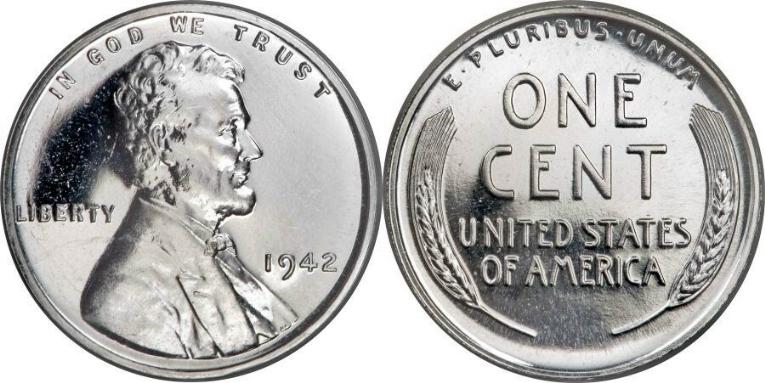 |  | 
  
This is a 1942 cent struck on a white metal planchet. It is believed to be a metallurgical trial by the Mint, using an experimental obverse die with wider rims and with the mottos closer to the rims than on the regular Lincoln cent dies. These were struck as a replacement to copper which was needed for the World War II effort. For more on these, we recommend the article "1942 High Relief Cent Pattern" by David McCarthy which appeared in the January 2019 edition of the Numismatist.
The following examples are confirmed:
1) Stacks 9/96, Heritage 97 ANA, Superior 3/00, southern collection, Stacks 7/08, Heritage 1/16 FUN lot 5743 as PCGS65, D McCarthy as PCGSSP65 - 88% Tin, 6.4% Copper, 5.1% Antimony with traces of iron (listed as .25%).
2) Goldberg's 5/03, Heritage 1/16 FUN lot 5742, Legend Auctions 9/16 - PCGS64 and is 93% tin, 7% antimony.
3) Heritage 4/20, Heritage 5/23 - NGC XF details and is 86.4% tin, 8.4% antimony, 1.8% copper, and 1.0% vanadium.
The earliest known listing for one of these is ex Farouk, Bolender 10/54 and is likely one of the first 2 listed above.
There also exists a magnificent Proof example on a thick aluminum planchet struck using the regular proof dies. That piece was originally misattributed by PCGS as J-2081 and consigned to the Heritage 3/08 sale, but was withdrawn when it was determined that the piece was in fact aluminum. It was subsequently re-offered in the Heritage 5/09 sale, properly described, and is illustrated below. It is now listed as J2079.

The following discussion of J-2079 is excerpted from the Heritage lot description.
The weight of the piece is 1.563 gm, about half the normal 3.11 gm. When the coin was resubmitted to PCGS and analyzed, its composition came back: aluminum 98.0%, silicon 0.7%, iron 0.6%, silver 0.5%, magnesium 0.4%. In July of last year Roger Burdette hypothesized:
"The assay: Al 98; Si 0.7; Fe 0.6; Ag 0.5 and Mg 0.4 is very significant. Although most of the piece is aluminum, the other elements are not impurities. Someone was making a deliberate attempt to test a harder, more durable alloy than plain aluminum. Aluminum-silver alloys can be extremely hard [although they are also extremely difficult to produce and usually require an atmosphere free of oxygen] and the quantity of silver necessary is small. The US Mint experimented with them as far back as the early 1860s, and James Ross Snowden conducted other experiments in about 1885. This assay suggests we will eventually identify many other experimental alloys, currently unknown, based on aluminum."
Burdette went on to state that even though the assay totals 100.2%, implying there is a 0.2% rounding error, "the important thing is that silver should not be present [unless the Mint were purposely trying to produce this difficult alloy], even if the cheapest aluminum scrap were used for experiments. (Fe [iron] and Si [silicon] are common impurities.)"
There was some controversy surrounding the J2079 preceding the Heritage auction. Some prospective bidders had significant concerns that the piece might not be an authentic U.S. Mint product. This was based on several characteristics of the coin:
1. The coin lacked some detail, especially on the obverse. (I recognized this as being common for 1942 proof cents, the result of excessive polishing of the dies, so this didn't bother me as much as it did others.)
2. The surfaces exhibited some raised "pimples", which are sometimes seen on counterfeit coins. These particular pimples were not rounded and lumpy as usual, but had been substantially softened, most likely the result of the polishing of the dies.
3. The open fields of the coin exhibited some "as made" pitting of the fields. None of the numismatists discussing the coin recalled seeing anything similar on other coins.
4. There were some "as made" marks on some of the higher points of Lincoln's portrait. There was a concern that these may have been on the die, the result of transfer dies created from a coin with similar bagmarks.
Subsequent research has determined that all of the above characteristics are commonly seen on 1942 proof Lincoln Cents. The problem, it seems, is that the doubters of the unique aluminum proof never bothered to study the common bronze proofs of the same year.
The coin was purchased by Mike Byers and reoffered in Heritage 4/14 sale.
In any event, it can now be stated without question that the piece is authentic.
Zinc coated steel examples are also reported and are now listed as J2080 although none are presently confirmed.
Photos courtesy of Heritage.
|
|

